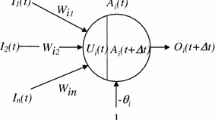Abstract
Most of the tasks which require intelligent behavior have some degree of uncertainty associated with them. The occurrence of uncertainty might be because of several reasons such as the incomplete domain knowledge, unreliable or ambiguous data due to measurement errors, inconsistent data representation. Most of the knowledge-based systems require the incorporation of some form of uncertainty management, in order to handle this kind of indeterminacy present in the system. In this paper, we present one such method to handle the uncertainty in neurules, a neuro-symbolic integration concept. Neuro-Computing is used within the symbolic frame work for improving the performance of symbolic rules. The uncertainty, the personal belief degree that an uncertain event may occur is managed by computing the composite belief values of incomplete or conflicting data. With the implementation of uncertainty management in neurules, the accuracy of the inference mechanism and the generalization performance can be improved.
Similar content being viewed by others
References
Asuncion, A., Newman, D.J.: UCI Machine learning repository, http://www.ics.uci.edu/mlearn/MLRepository.html, School of Information and Computer Science, University of California (2007)
Konar, A.: Artificial intelligence and soft computing : behavioral and cognitive modeling of the human brain. CRC Press, Boca Raton (2000). ISBN 9780849313851-CAT#1385
Konar, A.: Computational intelligence principles, Techniques and applications, ISBN 3- 540-20898-4. Springer, Berlin (2005)
Article, Wikipedia, the free encyclopedia, http://en.wikipedia.org/wiki/Dempster%E2%80%93Shafertheory (2011)
Bader, S, Hitzler, P. In: Artemov, S., Barringer, H., d’AvilaGarcez, A.S., Lamb, L.C., Woods, J. (eds.) : Dimensions of neural-symbolic integration-a structured survey, We will show them: Essays in Honour of DovGabbay, vol. 1, pp. 167-194. College Publications, Oxford (2005)
Bader, S., Hitzler, P., Holldobler, S., Witzel, A.: A fully connectionist model generator for covered first-order logic programs. In: Proceedings of the 20th Int’l Joint Conf.Artificial Intelligence(IJCAI ’07), pp. 666–671 (2007)
Bader, S., Hitzler, P., Holldobler, S.: Connectionist model generation: a first-order approach. Neurocomputing 71, 2420–2432 (2008)
Bookman, L., Sun, R.: Connection Science, special issue on integrating neural and symbolic processes, eds., vol. 5, nos. 3/4(1993)
Cloete, I., Zurada, J.M. (eds.): Knowledge-based neurocomputing. MIT Press, Cambridge (2000). ISBN:9780262032742502
d’Avila Garcez, A.S., Broda, K, Gabbay, D.M.: Symbolic knowledge extraction from trained neural networks: a sound approach. Artificial Intelligence 125(2001), 155–207 (2001). Elsevier Science B.V.
Fu, L.M.: Knowledge-Based Connectionism for Revising Domain Theories. IEEE Trans. Syst. Man Cybern. 23(1), 173–182 (1993)
Gallant, S.I.: Connectionist expert systems. Comm. ACM 31(2), 152–169 (1988)
Gallant, S.I.: Neural network learning and expert systems. MIT Press, Cambridge (1993). ISBN:9780262071451382
Shafer, G.: Dempster-Shafer Theory,” Article, fitelson.org/topics/Shafer.pdf (1990)
Hammer, B., Hitzler, P.: Perspectives of Neural-Symbolic Integration, vol. 77. Springer, Berlin (2007). ISBN:978-3-540-73954-8. https://doi.org/10.1007/978-3-540-73954-8
Hatzilygeroudis, I., Prentzas, J.: Neurules: Improving the performance of symbolic rules. Int’l J. AI Tools (IJAIT) 9(1), 113–130 (2000)
Hatzilygeroudis, I., Prentzas, J.: Using a hybrid Rule-Based approach in developing an intelligent tutoring system with knowledge acquisition and update capabilities. J. Expert Syst. Appl. 26(4), 477–492 (2004)
Hatzilygeroudis, I., Prentzas, J.: An efficient hybrid rule based inference engine with explanation capability. American Association for Artificial Intelligence http://www.aaai.org (2001)
Hatzilygeroudis, I., Prentzas, J.: Constructing modular hybrid rule bases for expert systems. Published in the International Journal of Artificial Intelligence Tools (IJAIT) 10(1-2), 87–105 (2001)
Hatzilygeroudis, I., Member, I., Prentzas, J.: Integrated rule-based learning and inference. IEEE Trans. Knowl. Data Eng. 22(11), 1549–1562 (2010)
Hatzilygeroudis, I., Prentzas, J.: Multi-inference with Multi-neurules SETN 2002, LNAI 2308, pp. 30–41. Springer, Berlin (2002)
Hatzilygeroudis, I., Prentzas, J.: Neuro-symbolic approaches for knowledge representation in expertSystems. Published in the International Journal of Hybrid Intelligent Systems 1(3-4), 111–126 (2004)
Prentzas, J., Hatzilygeroudis, I., Tsakalidis, A.: Updating a hybrid rule base with new empirical source knowledge. In: Proceedings of the 14th IEEE International Conference on Tools with Artificial Intelligence. $17.00 ⒸIEEE, pp. 1082–3409/02 (2002)
Prentzas, J., Hatzilygeroudis, I.: Rule-based update methods for a hybrid rule base. Data Knowl. Eng. 55(2005), 103–128.0169-023 (2005). X/$, Elsevier
Sentz, K.: Jan./Feb combination of evidence in Dempster-Shafer theory. Binghamton University, April (2002)
Ling, X., Rudd, W.G.: Combining opinions from several experts. Applied Artificial Intelligence 3, 439–452 (1989)
Hillario, M.: An Overview of strategies for Neurosymbolic Integration, Connectionist-Symbolic INtegration form Unified to Hybrid Approaches. In: Sun, R., Alexandre E. (eds.) Lawrence Erlbaum (1997)
Prentzas, J, Hatzilygeroudis, I.: Construction of Neurules from training examples: a thorough investigation. In: Garcez, A., Hitzler, P., Tamburini, G. (eds.) Proceedings of the ECAI- 06 Workshop Neural-Symbolic Learning and Reasoning (NeSy ’06), pp. 35–40 (2006)
Simon, C., Weber, P.: Bayesian networks implementation of the dempster- Shafer theory to model, Reliability uncertainty. In: Proceedings of the First International Conference on Availability, Reliability and Security, pp. 788-793,ISBN:0-7695-2567-9 (2006)
Sima, J., Cervenka, J. In: Cloete, I., Zurada, J.M. (eds.): Neural knowledge processing in expert systems, Knowledge- based neurocomputing, pp. 419–466. MIT Press, Cambridge (2000)
Smets, P., Kennes, R.: The transferable belief model. Artif Intell 66, 191–243 (1994)
Xianyu, J.C., Juan, Z.C., Gao, L.J.: Knowledge-Based neural networks and its application in discrete choice analysis,” pp. 491–496 (2008)
Wermter, S., Sun, R.: Hybrid neural symbolic integration. In: Workshop as part of International Conference on Neural Information Processing Systems, Breckenridge, Colorado, December 4 and 5 (1998)
Acknowledgements
The authors would like to thank Prof. Pushpak Bhattacharyya, Prof. D. Malathi for his support and guidance during this work. The authors would like to thank Department of Science & Technology, Govt. of India for providing fund under Woman Scientist Scheme (WOS-A) with the project code-SR/WOS-A/ET/1075/2014.
Funding
This work is funded by Department of Science & Technology, Govt. of India under Woman Scientist Scheme (WOS-A) with the project code-SR/WOS-A/ET/1075/2014.
Author information
Authors and Affiliations
Contributions
The first author is the sole author of this work.
Corresponding author
Ethics declarations
Competing Interests
The author declares that there is no competing interest.
Rights and permissions
About this article
Cite this article
S., S. NeuroSymbolic integration with uncertainty. Ann Math Artif Intell 84, 201–220 (2018). https://doi.org/10.1007/s10472-018-9605-y
Published:
Issue Date:
DOI: https://doi.org/10.1007/s10472-018-9605-y




